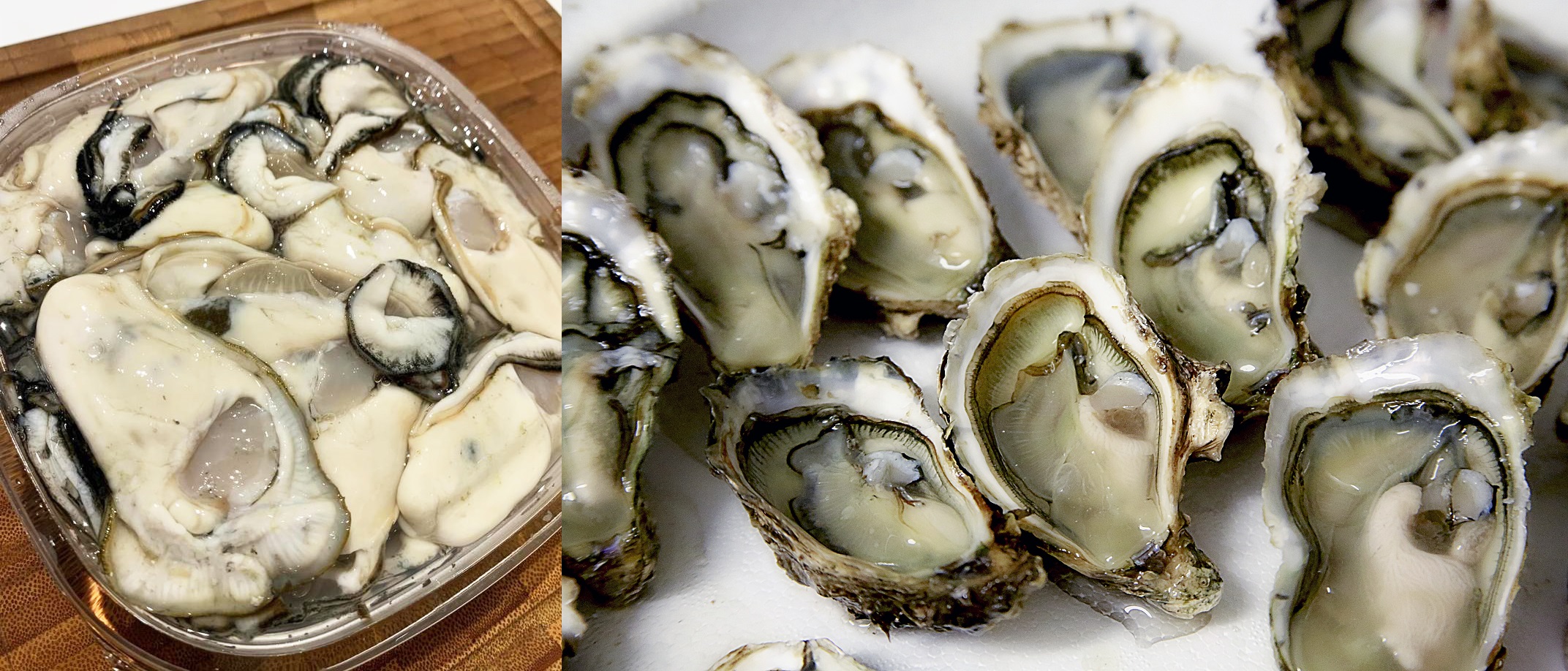
Food Safety Focus (180th Issue, July 2021) – Incident in Focus
Pre-shucked Oysters for Raw Consumption –
What Should One be Aware of?
Reported by Mr. Arthur YAU, Scientific Officer,
Risk Communication Section, Centre for Food Safety
The market sees an increasing popularity of imported pre-shucked raw oysters packed in plastic tubs, which are allegedly fit to be consumed raw. While the stake of food poisoning that the raw shellfish, including marinated ones, poses are well known, in this article we shall focus on the microbiological risks specifically involved with pre-shucked raw oysters.

Figure 1: A photo of chilled pre-shucked raw oysters in a plastic tub and half-shell raw oysters
Raw Oysters are High-risk Foods
Oysters are filter feeders. They constantly draw in water and accumulate materials from water, including pathogens such asVibrio bacteria, norovirus and hepatitis A virus. These pathogens can infect people who eat oysters raw or undercooked. In addition, bacteria like Vibrio can continue to grow in oysters after harvesting if oysters are not maintained at low enough temperatures from harvest through to consumption. Food poisoning outbreaks related to raw oysters have been reported locally from time to time. Although the illness is usually mild and self-limiting, causing symptoms such as diarrhoea, abdominal cramps and vomiting, they can also cause severe health consequences especially for susceptible individuals.
Additional Risks in Shucked Oysters
Both physical and microbiological contamination are possible during the shucking of oysters. Physical removal of shellfish meat from the shell at the shucking table often exposes the product to dirt, mud and detritus. Shucked oysters should be rinsed or washed well to eliminate these contaminants and to reduce microbiological level of the products. Good hygiene practices should also be observed to minimise contamination from the workers and the working environment.
Before deshelling, oysters can stay alive even after long-haul shipping if kept under correct temperature and conditions. Once killed after shucking, raw oysters can deteriorate quickly if the temperature is not low enough to limit bacterial growth. Shucked oysters should be packed and chilled or frozen as soon as possible. Furthermore, an uninterrupted cold chain during transportation is critical to ensure safety and quality of the shellfish products.
Thorough Cooking – the Sure Way to Destroy Pathogens
Pathogens can be readily destroyed by cooking, but high heat must be held to be effective. Cooking to an internal temperature of 90°C for 90 seconds will provide a safety margin to inactivate common foodborne viruses like hepatitis A and norovirus. Remember that raw oysters have an inherent microbiological risk that cannot be completely eliminated, even with stringent control and monitoring measures at farm level. However, if choosing to savour the shellfish raw, buy oysters intended for raw consumption only from reliable licensed premises.
Importers should confirm that the raw oysters they import are fit for human consumption by obtaining relevant health certificates issued by relevant authorities of the exporting countries. In Hong Kong, a restricted food permit is required to sell oysters to be eaten in raw state. Raw oysters should be received and kept at 4°C or below all along at food premises. Food handlers should minimise the time spent outside of refrigerated control during rinsing, cleaning, shucking and other preparations of oysters. Different lots and varieties of oysters should be stored in separate containers labelled with date and variety. Keep shellfish harvest tag and/or relevant documentation of treatment with each batch of oysters until service.
Key Points to Note
- Consuming raw oysters poses a high risk. Chilled pre-shucked oysters for raw consumption are riskier due to their susceptibility to temperature abuse during transportation and the subsequent rapid bacterial growth.
- Thorough cooking can destroy the foodborne pathogens in oysters.
- Susceptible populations should not consume raw or undercooked oysters.
Advice to the Trade
- Importers of oysters for raw consumption should obtain health certificates issued by relevant authorities of the exporting countries.
- Food businesses should obtain a restricted food permit / written endorsement for licensed premises before selling oysters for raw consumption.
- Oysters for raw consumption must be received and maintained at 4°C or less before service to ensure pathogens do not have the chance to grow.
- Food premises serving raw oysters are advised to display a consumer advice in the menu or on a display card at the table.
Advice to the Public
- Chilled oysters for raw consumption that are imported pre-shucked are particularly risky. Avoid consuming them.
- Purchase oysters for raw consumption only from reliable licensed premises, including those that are online. Look out for the condition and expiry date for prepackaged products.
- Cooking oysters to an internal temperature of 90°C for 90 seconds to kill harmful bacteria and viruses is the only sure way to destroy the foodborne pathogens in them.
- Pregnant women, infants and young children, the elderly and people with weakened immunity should not consume raw or undercooked oysters.

